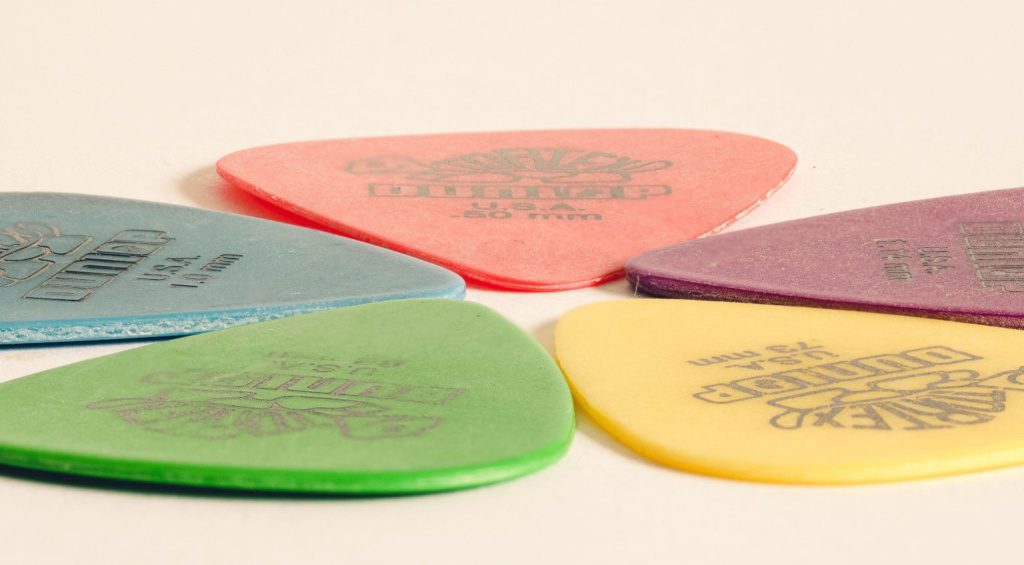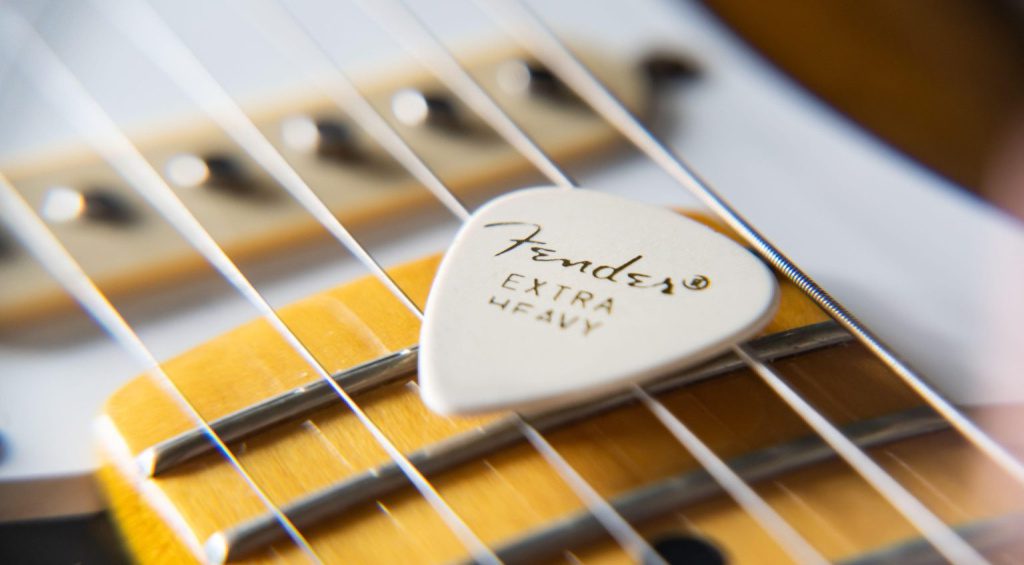Guitars, effects, amps, and cables can cost hundreds, even thousands of dollars. They’re all equally important for your sound, of course. But what about the guitar pick? Unless you’re a finger-picking ace, that little plastic thing probably touches your strings a lot more than your picking hand. That’s a good reason to take a closer look. Here are our recommendations for the best guitar pick, sorted by style and sound!
For many guitarists, choosing the right guitar pick is an often overlooked but critical decision. It’s not just an ordinary piece of plastic or metal; it’s the link between the player and the guitar strings. This small thing can make a big difference in the instrument’s sound, feel, and expressiveness.
There are so many different guitar picks on the market these days. They come in all shapes and sizes, and with many different materials, textures, and thicknesses, it can be hard for someone new to the guitar to know where to start when looking for the best guitar pick.

So, this guide aims to offer some guidance and introduce various picks suitable for different styles and sounds to you. Whether you play rock, metal, jazz, blues, or folk, you’ll find helpful tips and recommendations to help you find the best guitar pick. To clarify, I’m talking about the guitar picks you actually play with. You can find other investments elsewhere—like a guitar pick for $15,000. But before we get to the picks that are particularly suitable and recommended, let’s look at the main characteristics to differentiate them.
The best guitar pick: What is it made of, and how do different materials affect your playing?
The material of a plectrum makes a big difference in how it sounds and feels. Different materials have different properties that might be better for certain types of music. Here’s a brief look at the most common materials used to make guitar picks:
Plastic (e.g. nylon, delrin, tortex, ultex, etc.):
Plastic is the most common material used for guitar picks, but the plastic mixtures used differ quite a bit. For instance, nylon picks are known for their flexibility and durability. They were developed as a replacement for tortoiseshell. They produce a warm, soft sound.
Delrin picks, often called “Tortex,” are more rigid and less flexible, but they offer excellent control and durability. It’s important to note that Ultex, Tortex, and Co. aren’t scientific descriptions of certain materials but mere product descriptions. No scientist would know anything about “Tortex.”
Metal:
Often made of stainless steel or brass, metal guitar picks are much more rigid and heavier than their plastic counterparts. They produce a very assertive sound, which is excellent for fast and precise playing. Metal picks are more commonly used in genres such as metal and hard rock, where an aggressive tone is desired.
However, anyone who used a coin as a plectrum when they didn’t have a suitable one also knows about the harsh sounds they can produce. And about the damage strings take when you’re using a metal guitar pick when it’s raining.
Wood:
Wooden picks aren’t as common but they allow for a unique, much warmer, and natural sound. They’re usually thicker and less flexible than plastic or metal picks. Wooden picks are great for acoustic guitar and folk music because they produce a soft, round sound. Another advantage is that they’re comfortable to hold, even with sweaty hands, because of the wood’s rugged pattern.
Bone/Horn:
Bone or horn picks are extremely durable and produce a really clear, bright sound. They’re often pricier and less common, but they offer excellent control and precision. These guitar picks are often used where a very defined and articulated sound is desired, like in traditional or classical music styles.
Choosing a particular material can significantly influence the sound of your guitar. You’ll automatically adapt your playing style when you play with a new guitar pick. In the next section, we take a closer look at the different shapes of the best guitar picks.
The perfect plectrum – shape and size
The shape and size of a pick can make a big difference in how it feels while playing. I don’t know how long it took me to figure out the best pick grip, but it was a pretty long-winded process. Several standard shapes have proven themselves over time and are used by most guitarists. Here are some of the most common pick shapes and their characteristics.
Standard pick: the legendary 351
This is probably the most well-known and most widely used type of guitar pick. It comes with a wide, rounded edge that is perfect for rhythmic strumming and chord playing. You won’t find sharp edges or particularly emphasized tips for fast single-note picking here. These “standard picks” are available in various materials and thicknesses. They’re great for rock, pop, or acoustic guitar—an absolute all-rounder that you’ll find in every gig bag.
Jazz III Guitar Pick:
The Jazz III pick is smaller and more pointed than the standard one, making it great for fast, precise playing techniques. Its sharp tip makes quick changes and detailed articulation a breeze, which is why it’s a hit with jazz and metal guitarists. The compact size takes some time, but it offers exceptional control and precision. I think the recent success of the Jazz III picks comes from a few highly-regarded signature picks: Petrucci, Johnson, Hammett, Bonamassa, and others.
Teardrop-shaped picks
These smaller picks are also tapered but a bit rounder than the Jazz III. They strike a good balance between precision and comfort and are great for both lead and rhythm playing. Their small size makes them a popular choice with guitarists who prefer a more direct feel with the strings. Teardrop picks are versatile and work well for a variety of musical styles, including blues and folk. Among Fender users, Teardrop picks are also known as 358 or 354 picks.
Pick thickness and its (true) meaning
The thickness of a guitar pick makes a big difference in the sound and feel. Thinner plectrums are more flexible and produce a softer, less defined sound, while thicker plectrums are more rigid and produce a more precise tone.

In my experience, thicker picks tend to feel more controlled. They provide immediate feedback, and their rigid form eliminates one variable, particularly in fast passages. However, the opposite is true when it comes to chords and open strumming.
The market typically categorizes guitar picks as extra light (0.38–0.5 mm), thin/light (0.50–0.70 mm), medium (0.70–0.90 mm), heavy (0.90–1.2 mm), and extra heavy (thicker than 1.2 mm). For simplicity, I’ll focus on thin, medium, and heavy in this section.
Thin picks (< 0.5 mm):
Thin picks are very flexible and great for gentle strumming and rhythmic playing. They produce a soft, bright sound and are popular with acoustic guitarists. The downside is that they don’t give you as much control over fast arpeggios.
Medium picks (0.5 mm – 1 mm):
These picks strike a good balance between flexibility and stiffness. They’re versatile and work well for a variety of playing techniques, from strumming to precise picking. Many guitarists prefer medium picks because they’re suitable for both rhythmic playing and solos. I’m willing to bet that just every one of you has held a 0.88 Tortex (“the green ones”) in your hand.
Thick picks (> 1 mm):
Thick picks are stiff and give you a lot of control and precision. They produce a powerful, assertive sound and are great for fast, technical playing styles like shredding and lead guitar parts. Metal and jazz guitarists love thick picks because they’re stable and produce a clear, defined tone. As Troy Grady, who knows a thing or two about pickslanting, says, “More reliability, more control, more speed.”
Hold on tight: textures and grip
One thing many people forget when they’re choosing the best guitar pick is its texture and grip. The texture of a guitar pick affects how well it fits in your hand and how securely it can be held while you’re playing. Different surfaces have different advantages and disadvantages. Depending on how much your fingers move around, that is.
Smooth plectrums:
Smooth guitar picks glide smoothly over the strings, giving you a consistent playing feel. Their downside is that they can slip out of your hand more easily during extended sessions or when your hands are sweaty. Smooth picks are great for players who prefer a fast and fluid movement. If you like the feel of smooth picks but keep finding them on the stage floor, you might want to look out for good wooden picks. Thanks to their rugged fabric, these are less prone to slipping out of your hand.
Textured picks:
Textured picks give you extra grip through patterns or rough surfaces. These textures help you hold the pick securely between your fingers, which can be very helpful during intensive sessions. Textured picks are great for guitarists who need extra support to prevent slipping. Whether Jazz III or Dunlop Flows, which I love, a good grip is critical.
Special coatings (e.g. Dunlop Max-Grip):
Some manufacturers offer picks with special coatings or patterns that are designed to improve grip. These special coatings are popular with guitarists who need a high level of control without sacrificing playing comfort. Picks with higher thicknesses (1 mm and more) are the epitome of control when combined with these coatings.
The best guitar pick for your sound – recommendations for every genre
But the question remains: Which is the right pick for your style? Here are our recommendations for different genres based on material, shape, and thickness:
The perfect guitar pick for rock/metal
If you’re playing in harder, faster genres, you’ll definitely want to checkout out picks made of Delrin (plastic). It offers a high level of control and precision. Jazz III picks are popular with shredders because of their sharp tip and compact size, which is great for fast and technical playing. Textured picks with a good grip prevent slipping during intense playing sessions. My personal favorite is the Dunlop Flow Standard Pick 1.50 oxblood.*
These offer the perfect combination of good grip and extreme durability. The particularly hard plastic delivers clean hits and rich overtones. Thanks to the slightly more pointed tip, fast solos are also possible – as long as your skills allow.
Jazz — grip and delicate tip
I’m definitely not a jazz guitarist, but I know a few. Many prefer small, pointed picks like the Jazz III, which offers excellent articulation and control — as long as you can get used to its rather limited grip surface. In addition to the classic plastic picks, picks made of nylon or bone are particularly popular because they produce a warm, defined sound. A higher thickness makes these guitar picks easy to control and perfect for complex chords and fast runs.
I often reach for the Jazz III Max Grip* when I’m working on challenging and fast songs. The fine tip of the pick, combined with the “non-slip” surface of the Max Grip, is such a tremendous help. It frees up my hands, so I can focus on playing instead of holding on.
The guitar pick for blues
Medium-thick guitar picks made of materials like Tortex or nylon are fantastic for blues music. They offer a good balance between flexibility and control, which is important for both rhythmic strumming and lead playing. Teardrop plectrums are also a good choice because they enable precise strikes and produce a warm tone.
The bluesman is looking for the perfect balance: not too hard, not too soft. This is what you want in an amp and a guitar pick. My advice would be the Dunlop Flow Standard*. Its slightly sharpened tip can handle fast alternating strokes just as easily as the occasional strumming.
Acoustic/Folk — thin and pliable
Nylon or Tortex picks are great for acoustic and folk guitarists. They’re flexible enough for gentle strumming and produce a soft, bright sound. Standard or teardrop shapes are really popular.
I’ve been using a Harley Benton Small Tear Drop* pick on my Takamine from Japan for years. Its slim teardrop shape and thickness of 0.71 mm make it perfect for loose and relaxed strumming. The warm character of the celluloid gives it a great sound.
Conclusion on the best guitar pick
Picking the best guitar pick is a big decision for every guitarist. Understanding the different materials, shapes, thicknesses, and textures helps you find the perfect pick for your playing style and sound preferences. Try different picks to find the one that’s right for you. The best advice I ever got is to take a new pick with you to every gig. You never know what you’ll discover.
More on the best guitar pick
Note: Originally published at Gearnews.de by Jan Rotring, translation by Julian Schmauch.
*This post contains affiliate links and/or widgets. When you buy a product via our affiliate partner, we receive a small commission that helps support what we do. Don’t worry, you pay the same price. Thanks for your support!






